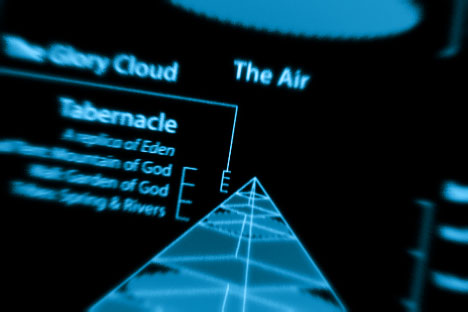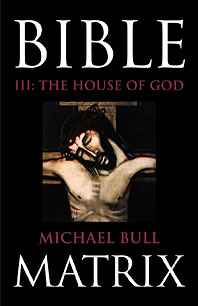Preface
[draft]
ALL THE WORLD REALLY IS A STAGE. In Creation, God calls things from nothing. By Covenant, He gives them differing roles and suitable authority. In His House, He prepares for them a place to perform.
The events of the Bible take place within a cosmic theatre, one based upon the structure of heaven. Just as the plays of Shakespeare were written for the Globe Theatre, so the visions and prophecies of the Bible take place within a predetermined architectural space. The writers assume that we are familiar with not only the layout of this arena and the significance of the elements contained within it, but also with the relationships between those elements.
This means that an understanding of the symbolic significance of the physical elements in the literal, historical creation account in Genesis 1 is of critical importance. It gives us incredible insights into the structure of many prophetic Bible passages and the order of many historical events. The layout of the House of God informs not only the Law and the Prophets, but also the ministry of Jesus and the apostles. When we get to the Revelation, familiarity with this constructed “set” and its liturgical scenery is crucial to determining its fulfillment in history.
The fact that all of the Bible takes place within a “virtual reality” like the Globe Theatre does not abstract the Bible from reality. Rather, its liturgical architecture gives us the keys to understanding the anatomical, social and cosmic “houses” based upon the same plan, the houses in which we live.
The design of God’s House is the expression of God’s nature. The physical Creation and the human life which crowns it are also expressions of that nature. Thus, every aspect of human life is founded upon the same blueprint as the House of God. The significance of each room and furnishing in God’s House is replicated in some way in the Church, in family life, in education, in law, in business, in the arts and sciences, in government and in international relations. An understanding of biblical architecture means we are not limited like unbelievers to simply figuring out, by trial and error, what works best. Being “at home” in the house of God not only makes plain to us what works but also gives us an insider’s knowledge of exactly why it works. Rather than remaining a mystery to Christians, a grounding in the architectural models in the Bible reveals the dwelling places of God as deep sources of life and wisdom.
To be at home in the House of God is to be at home in the world. We cease to cut against the grain of the way things are. We choose to live by God’s laws because we recognize them as tools for true progress and lasting beauty.
At the heart of this recognition is a new vision. A love for God has replaced the idolatrous love of the world which John warns us against. Enamored instead with heaven, God’s people will consistently place the best gifts in this glorious world on the altar, in faith that God may send an even greater harvest.
As the “word-and-response” liturgical life of the heavenly Temple shapes our earthly thinking, we will be equipped to transform every aspect of this world into its Trinitarian likeness, so that God may be more and more at home here in the world of men. And, as with the Tabernacle and Temple, our obedience as Spirit-filled craftsmen will be vindicated finally by the visible presence of God Himself.
Cross-eyed Exegesis [1]
What I am proposing is not another contrived hermeneutic [2], one more arbitrary lens we moderns can impose upon the Scriptures. The only logical solution to the various theological debates is the acknowledgement of the careful blueprint which is already present in the text. The literary-architectural nature of the Bible means that there is a place for everything and everything is in its place.
This “spatial grid” is inherent in the thought processes of the Great Author, the inspired mind of the biblical writers and in the literary outcome we possess today. As I will demonstrate, every line of text has two coordinates, a “warp” and a “weft.” In my experience, in cases where there are three or four theories or schools of thought concerning the intent of the author, or the historical referent of his text, the identification of the literary structure will usually identify which of those theories is correct. We simply need to learn to look at the two dimensional text in a new way.
Some readers of Bible Matrix get it straight away. Some get it after a while. Some will never get it. Perceiving the “shape” of the text is very much like looking at one of those “autostereograms” which were popular a few years ago. I was one of the people who stared and stared and stared and couldn’t see the 3D images hidden in the complex and apparently random screen of two dimensional visual information. When my brain finally clicked into gear and I did see one, it was a medium-to-large brontosaurus. How did I miss that? It was hidden in plain sight.
Identifying the Bible Matrix is the same. One must look at the text cross-eyed. If there is enough of a correspondence, your literary mind will align the two structures. (This is really no different than discerning the fundamental plot of one of Shakespeare’s plays retold in a novel or movie.)
The text of the Bible is architecture. It is a temple built row by row. This is not eisegesis. [3] It is simply a definition of exegesis that most Bible commentators are not much aware of. It is a process of noticing something in the text, or rather, something that the text is in—the structure. Once this is done, the passage can be corresponded with and contrasted to similar structures elsewhere in the text, which allows them to comment on, to “speak to,” each other. “Systematic typology” is inherently triune. Because every part of the Bible is stamped with the same image, it reflects and expounds upon every other part of the Bible. This is not only the case with the structure or “house” of the text, but also of the created objects, the furnitures placed within it.
In a universe of types and symbols, everything is self-effacing. Every created thing points to, speaks of, something else in Creation, and all Creation ultimately points us back to the Trinity, the Perfect Unself.
History is a Hive
Compared to the complicated glory of the completed Bible, the basic grid upon which it is founded is relatively simple. This brings us back to the “fractal” nature of both the created world and the written Word.
The science of fractals has enabled us to measure, and to replicate, the apparent “roughness” of things in nature. Coastlines and mountain ranges and cloud formations all once seemed to be beyond the clean lines of mathematics until the development of fractal geometry. This science has not only revealed that complex shapes can “grow” organically from simple formulae, and that nature itself utilizes these forms to achieve both efficiency and beauty, it has allowed us to replicate the process (lifelike computer graphics are a good example).
But my point here is that, as Bible readers, we ought to be able to recognize the simple formula laid down in the early chapters in even its most complicated outcomes.
A suitable name for this multi-layered architectural awareness might be “spatio-fractal thinking.” For the reader of the Bible, this means being able to walk into the most complicated and dazzling “rooms” of the Bible (for instance, the prophecies of Ezekiel, Zechariah or the Revelation) and discern the Edenic blueprint beneath the glorious layers of historical allusion and prophetic promise which have been added to it throughout Covenant history. After all, a palace and a stable both have a roof and a door. Beneath the more glorious house we desire is always the functional house we need.
Beyond this, such familiarity with the process of maturation and glorification also gives the reader the intuition required to work out the significance of those augmentations and exactly why they were made.
Geo-Architecture
The pattern of Eden informs the shape of the Tabernacle. In the book of Numbers, that pattern is “measured out” upon Israel. Once Israel takes possession of the Land of promise, Israel begins to measure that pattern out upon the nations of the World. A fuller understanding of the Bible’s spatio-fractal architecture has great benefits. It reveals the architectural boundaries of the promises of the prophets at any given time and their language ceases to confuse us. It also makes easy work of the disputes concerning Israel’s role in Covenant history.
Even better, since the various roles of Adam are represented in the Tabernacle furnitures, we begin to discern the same roles, or their perversions, in the history of the nations since the time of Christ. Who would have thought that the golden elements in the Holy Place hold the solution to the great conflicts of the world, including those of our own day? The tug-of-war between the serpent and Adam for the possession of Eve is still being played out upon the world stage.
Bible Mind Map
The best way to communicate the architectural nature of the Bible and the world is through diagrams, so this volume is even more pictorial than the previous Bible Matrix books. However, like those books, what is shared here is not so much a dissertation as an environment. It will most likely require more than a single read-through for it to sink in, however, it will enable you to read the Bible “with your eyes open.” As the architecture and its significance become familiar, you will find yourself not only living more comfortably in the Bible, but living more consciously as a priest, a king and a prophet, the three-fold Law of God expounded in you as a living sacrifice, your to-and-fro life itself an extension of the household of God.
______________________________________
[1] Exegesis means literally “to lead out.” In the context of studying a text, it means to get out of the text what is already in it.
[2] A hermeneutic is a theory or methodology of interpretation, especially in theology.
[3] In contrast to exegesis, eisegesis means to read into a text something that is not actually in it.



























